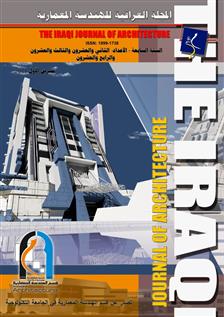The Effect of Residential Re- Subdivision
Abstract
This paper studies the concept of residential land re-subdivision, and the role of regulations,
instructions and standards in organizing this process, to provide residential plots which are suitable
in their dimensions and areas to the residence.
Residential re-subdivision affected by many factors such as number of new households, their
economic situation, and the plot areas; which enable the families to adopt this solution
The residential land re-subdivision is a good solution to reduce shortage in housing stock, and
minimizing the pressure on the residential demand , but at the same time it is a reason for increasing the
accommodation and population densities and the floor area ratio ( F.A.R) ,as well as increasing the
demand on the social and technical infrastructure .
The aim of this papers is to build a theoretical framework to the residential land re-subdivision,
determined the factors that affect on it, and its effects on the residential area.
The research problem is that, "residential re-subdivision effects on planning standards of the plots and
residential areas ", while the research hypothesis is that," the residential re- subdivision produced new
planning standards which have negative effects on the plots in residential areasâ€.
The research finding was that the residential re-subdivision was a main reason for reducing the
housing shortage, getting the new household a private residential space, at the same time; it was the
reason for raising the population, accommodation densities, and the floor area ratio.
Also the paper found that the residential re-subdivision has been according to the household need,
and according to the space left from the residential plot, without adherence to planning and standards
related to residential land subdivision ,this was the reason for the appearance of plots of different areas
and dimensions ,and some times of very small areas .
Downloads
You are free to use the work, but you have to attribute (refer to) the work in the manner specified by the author or licensor (but not in any way that suggests that they endorse you or your use of the work).
IRAQI J. ARCHIT & PLANN grants you the right to publish the metadata of the journal, it's issues and articles under the terms of the Creative Commons Attribution-ShareAlike 4.0 International License.
Author(s) hold the copyright of their aricles without restrictions. However, IRAQI J. ARCHIT & PLANN holds publishing rights for articles and their revisions once the article is published.
Authors can archive pre-prints (ie pre-refereeing) and post-prints (i.e. final draft post-refereeing) versions of the work they submitted to IRAQI J. ARCHIT & PLANN using non-for-profit open-access servers whether on author's personal website and/or institutional repositories including the university or research center where the author work.. For post-prints, only the IRAQI J. ARCHIT & PLANN’s as-published PDF version is permitted and the published source (IRAQI J. ARCHIT & PLANN’s website) must be clearly acknowledged within the archiving webpage.






